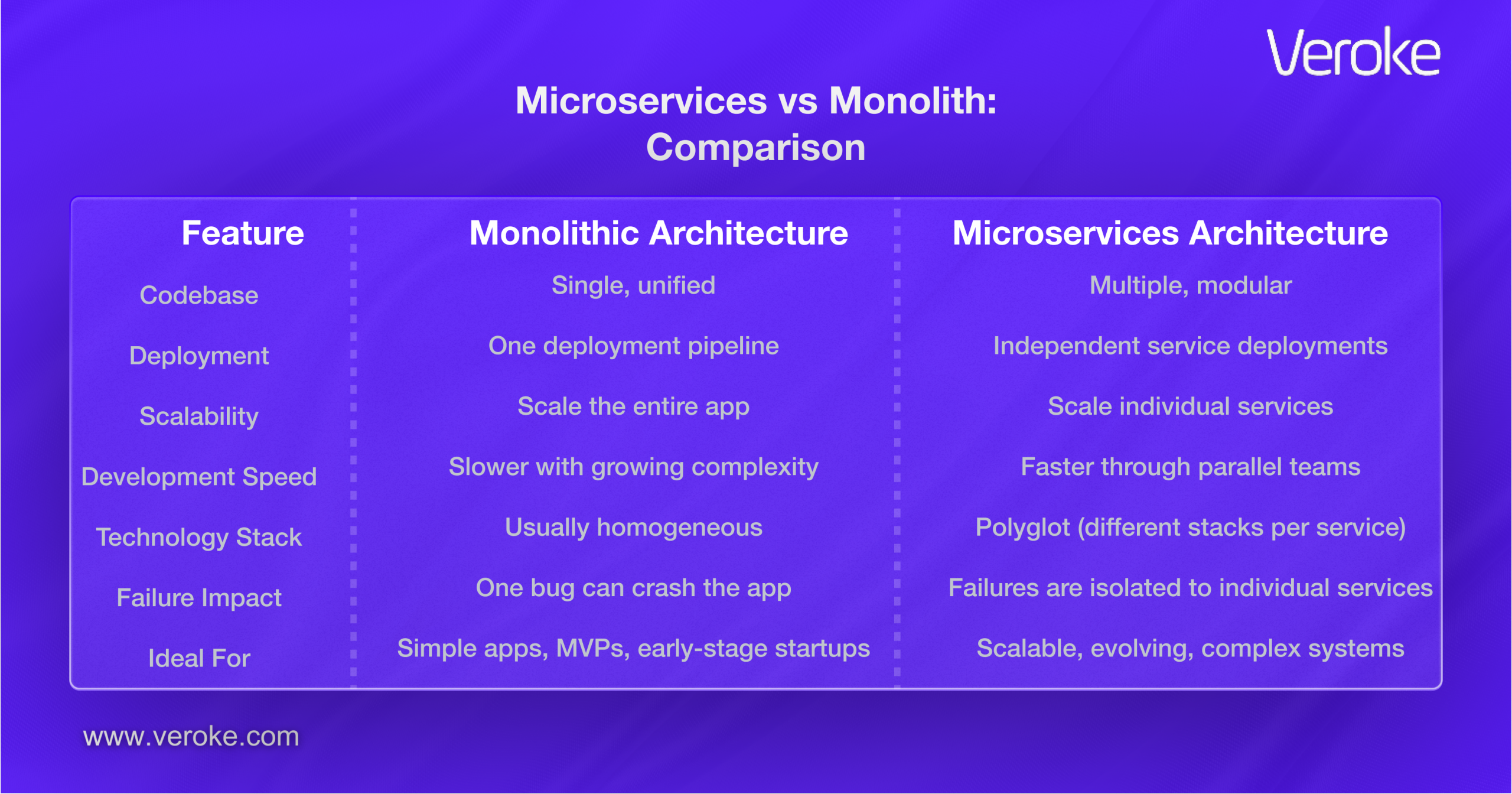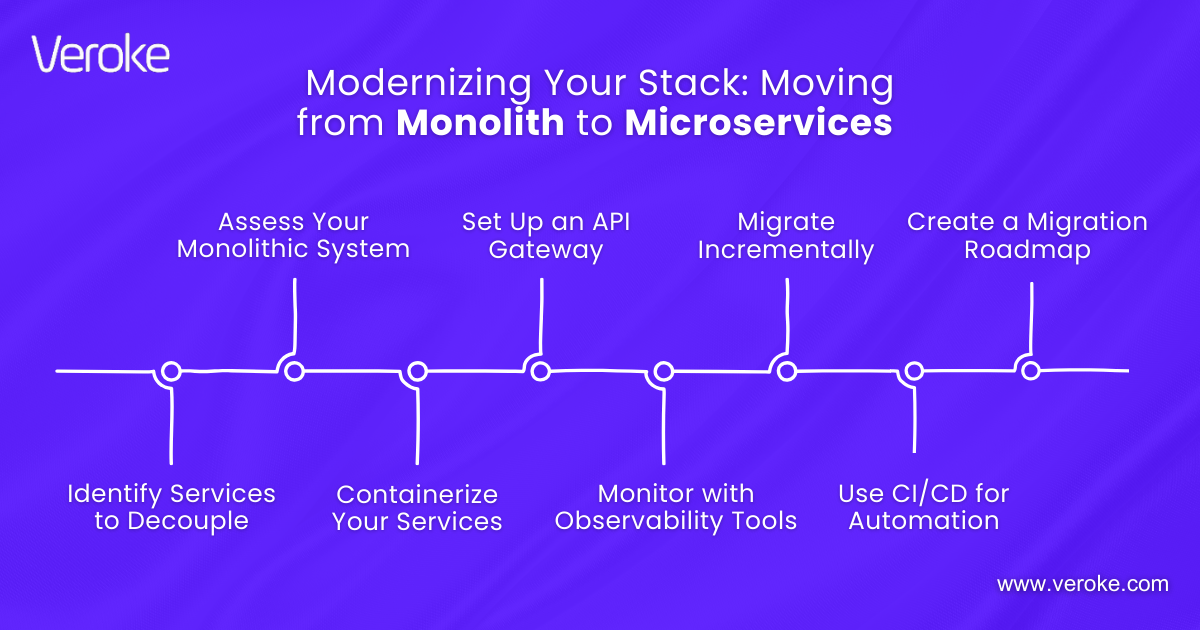Overview
Subscribe to Our Newsletter
Get expert guidance on various topics, resources, and exclusive insights
Monolith vs Microservices: What’s Best for Your Business?
Microservices are winning the business‑architecture race, and for good reason. Agility, scalability, and speed aren’t just nice‑to‑have features; they’re necessities.
That’s why a growing number of organizations are shifting from monolithic architectures to microservices. According to a 2021 Statista survey, 45% of companies use microservices for data analytics and business intelligence, highlighting just how integral this architecture has become for innovation‑driven businesses.
Unlike traditional monolithic architecture, which bundles all components into a single codebase, microservices break your application into independent, specialized services that can be developed, deployed, and scaled individually. This modular approach allows teams to work faster, fix issues quicker, and experiment without risking the entire system.
In this blog, we’ll walk you through the differences between monolithic and microservices architectures and explain why choosing microservices early on can set your business up for long-term success.
Breaking Down the Monolith vs Microservices Architecture
To truly understand why microservices are gaining so much traction, it’s essential to first understand how they differ from the traditional monolithic approach. Let’s break down both architectures to see what sets them apart.
What is a Monolithic Architecture?
A monolithic application is built as a single, indivisible unit. All the features, from the user interface to the business logic to the database layer, are tightly woven together in one codebase. When you update one feature, you rebuild and redeploy the entire application.
While this architecture is simple to develop initially, it quickly becomes difficult to manage as the application grows. Imagine making a small change in a massive codebase, it’s like untangling a ball of yarn.
What is a Microservices Architecture?
In contrast, microservices architecture breaks down the application into a collection of small, loosely coupled, and independently deployable services. Each service is responsible for a specific business function, authentication, billing, notifications, etc., and communicates with other services through APIs.
Think of it like building with LEGO bricks: each block is independent, reusable, and can be swapped or upgraded without impacting the entire structure.

Microservices vs Monolith : Quick Comparison
Microservices: The Blueprint for Future‑Proof, Scalable Software
In this section, we’ll explore how microservices have overtaken monoliths in the race for agility and resilience—and why adopting them now positions your organization to scale, pivot, and innovate without limits.
1. Unmatched Scalability
Let’s face it: not every part of your app needs to scale equally. In a monolithic architecture, if one feature spikes in demand, you’re stuck scaling the entire application, dragging along features that don’t need the extra horsepower. It’s like upgrading your whole car because one tire needs replacing.
Microservices change the game. You can scale only what needs to be scaled. If your inventory service is slammed during a flash sale, just spin up more instances of that service. No wasted resources. No unnecessary infrastructure costs.
This level of granular control means your app grows with your business, without becoming a slow, expensive monster to manage.
2. Rapid Development & Deployment
In today’s market, speed is survival. If you can’t launch new features fast or fix bugs quickly, you risk falling behind.
Microservices accelerate your delivery pipeline by breaking your application into independent modules. Teams can build, test, and deploy services in parallel, eliminating cross‑team bottlenecks and lengthy release cycles. Paired with CI/CD pipelines, this architecture turns small, frequent updates into a seamless routine—so you innovate continuously, minimize risk, and respond to user feedback in real time.
3. Tech‑Stack Flexibility & Agility
Traditional monoliths tie you to a single technology stack—limiting innovation and slowing upgrades. Microservices free you to pick the best tool for each task: Python for AI engines, Node.js for APIs, React for front‑ends, and more.
Each service runs in its ideal environment, optimized for performance rather than legacy constraints. At Veroke, we’ve empowered clients to future‑proof their products by seamlessly upgrading individual services and experimenting with new technologies—without overhauling the entire system.
4. Fault Isolation and Resilience
Imagine this: a single bug crashes one feature, and suddenly your whole app goes down. That’s the risk with monoliths, everything is tied together.
With microservices, that same bug stays isolated. If the payment service fails, users can still browse, search, and even contact support. The issue is contained, and the experience isn’t completely ruined.
This resilience builds trust with users and keeps your platform running, even when things go wrong. And let’s be honest, things do go wrong. The key is handling them gracefully.
5. Easier Maintenance and Updates
Keeping a monolithic app healthy can feel like maintaining a giant, fragile machine. One small change might ripple through the entire system, and not in a good way.
Microservices make life easier. Updates are small, focused, and quick. You patch what needs fixing without touching the rest. The smaller codebases are easier to test, debug, and improve over time.
For developers, this means fewer headaches. For users, it means smoother updates and a more reliable experience. And for businesses, it means faster innovation and lower downtime.
Real-World Use Cases: Why Giants Go Micro?
This isn’t just tech talk, it’s how the giants build, scale, and stay ahead. Microservices are the backbone of the world’s most successful digital platforms.
Let’s look at a few trailblazers:
➤ Netflix
Netflix was one of the earliest adopters of microservices, and for good reason. As millions of users began streaming content simultaneously across the globe, their original monolithic architecture just couldn’t keep up. By transitioning to microservices, Netflix gained the agility to scale services independently, deploy updates seamlessly, and handle massive traffic without a hiccup.
➤ Amazon
Amazon’s e-commerce platform is essentially a galaxy of microservices, each focused on a specific business function, from product listings to payment processing to customer reviews. Small, autonomous teams own these services, which makes innovation faster, maintenance easier, and the entire system incredibly resilient.
➤ Uber
Ever wondered how Uber matches riders and drivers in real-time, manages billing, sends you notifications, and calculates dynamic pricing, all at once? Microservices are the answer. Each of these features is powered by its service, enabling Uber to respond to real-time changes and scale globally without crumbling under pressure.
These companies didn’t just adopt microservices, they thrived because of them. They show us that when your architecture is designed to adapt and evolve, your business can do the same.
When Do Microservices Make the Most Sense?
Microservices are not a one-size-fits-all solution, but in many cases, they’re a strategic choice.
Let’s look at when microservices truly shine:
1. Building for the Long Term
If you’re developing a product meant to evolve, microservices offer a flexible foundation. With microservices, you can add new features (like analytics or multi-language support) without overhauling the entire system. They also allow for iterative development, easy versioning, and seamless scaling.
2. Multiple Teams and Faster Deployments
Microservices enable autonomous teams to own specific services. This reduces bottlenecks and accelerates development. Teams can push updates independently, without waiting for other modules to be ready, increasing engineering velocity and reducing deployment risks.
3. Scaling Across Regions and Devices
If you’re planning to expand globally or support multiple platforms (web, mobile, IoT), microservices provide the scalability and flexibility needed. You can scale services independently, deploy closer to users for better performance, and optimize across devices for a tailored user experience.
4. Gradual Modernization of Legacy Systems
Microservices simplify the shift away from monolithic architectures by enabling you to modernize legacy systems. Rather than rebuilding everything at once, you extract one capability at a time and integrate it with your existing system. This risk‑managed approach preserves functionality and minimizes disruption throughout the migration.
5. Startups Building for the Future
Even startups are adopting a “microservices mindset” when building their MVPs. Microservices allow you to focus on core features, experiment freely, and scale as you grow. This architecture not only supports rapid iteration but also makes your startup more appealing to long-term investors.
The Flipside of Microservices
Microservices bring power and flexibility—but they also add complexity. With dozens (or even hundreds) of services to manage, you’ll face more network traffic, distributed debugging challenges, and the need for stronger infrastructure and tooling. Spotting these hurdles early helps you plan smarter and avoid common mistakes.
1. Complex Service Communication
Microservices communicate via APIs, message queues, or event streams—which introduces latency, retry logic, and synchronization challenges. Implementing resilient patterns like circuit breakers, exponential back‑off, and service meshes is crucial to prevent failures from cascading across your system.
2. Deployment & Observability Overhead
Coordinating dozens—or even hundreds—of independent services demands mature DevOps processes. You’ll need containerization (Docker), orchestration (Kubernetes), automated CI/CD pipelines, and an observability stack (Prometheus, Grafana, Jaeger) to deploy reliably and catch issues before they impact users. To streamline this setup, you should opt for DevOps services that build and maintain robust automation pipelines, containerized environments, and real‑time monitoring systems.
3. Decentralized Data Management
When each service owns its own database, maintaining cross‑service transactions and generating consolidated reports becomes complex. Adopting patterns like Saga workflows, event sourcing, or CQRS helps you keep data consistent without sacrificing service autonomy.
The upside? You don’t have to figure this out alone. With the right expertise and modern cloud platforms, well‑established frameworks and tools can smooth the path, transforming microservices from a challenge into a scalable, sustainable advantage.
Modernizing Your Stack: Moving from Monolith to Microservices
Migrating from a monolithic system to microservices doesn’t need to be overwhelming. With a gradual and strategic approach, you can transform your architecture step by step without disrupting operations.

Modernizing Your Stack: Moving from Monolith to Microservices
1. Assess Your Monolithic System
Start by analyzing your current monolithic system. Identify the core modules that can be split into independent services without disrupting the functionality of the entire application.
2. Identify Services to Decouple
Look for low-risk, self-contained features or functionalities that can be separated first, such as:
- Authentication
- User profiles
- Notifications
- Payment or billing systems
3. Containerize Your Services
Once you’ve identified the first set of services, containerize them using tools like Docker. This ensures consistency in different environments (development, staging, production).
4. Set Up an API Gateway
To manage multiple services, implement an API gateway to route requests to the correct microservice. This simplifies traffic management and handles cross-cutting concerns like authentication and logging.
5. Monitor with Observability Tools
With microservices, monitoring becomes crucial. Set up tools like Prometheus, Grafana, and centralized logging to keep track of performance, errors, and service health.
6. Migrate Incrementally
Instead of migrating everything at once, move services incrementally. Keep the monolith running while you transition to microservices, ensuring minimal disruption.
7. Use CI/CD for Automation
Implement Continuous Integration and Continuous Deployment (CI/CD) pipelines to automate testing and deployment, making the migration process smoother and reducing the risk of errors.
8. Create a Migration Roadmap
Develop a clear, step-by-step migration plan, setting goals and timelines for each service migration. This will help keep the process organized and aligned with business objectives.
These simple steps will guide businesses through a gradual, risk-managed migration to microservices.
Final Verdict
The days when a single, all‑in‑one codebase could keep pace with business demands are over. Today’s software must scale seamlessly, adapt on the fly, and recover from failures without bringing everything down.
Microservices deliver exactly that by breaking applications into independent services—each one deployable, updatable, and scalable on its own. Adopting microservices does require an upfront investment in planning, DevOps practices, and the right tooling.
But the payoff is significant: you gain the freedom to ship features continuously, isolate and contain failures, and experiment with new technologies without overhauling your entire system. In short, you build an architecture that grows with your business instead of holding it back.
Whether you’re a nimble startup targeting rapid growth, a mid‑sized company seeking greater operational flexibility, or an established enterprise modernizing legacy systems, microservices can be the cornerstone of your long‑term success.
At Veroke, we partner with you to map out your journey, implement best‑in‑class pipelines, and ensure a smooth, risk‑managed migration. Ready to transform your software strategy? Let’s talk.
FAQs
1. Is microservices better than monolithic?
It depends on your project’s needs. Microservices shine in large, complex systems where you need independent scaling and rapid iteration. Monoliths are simpler to develop and deploy for smaller apps or teams.
2. Why move from monolith to microservices?
Shifting to microservices unlocks independent deployments, fault isolation, and tech‑stack flexibility. This lets teams deliver features faster and contain failures without taking down the whole system.
3. Which one is better, microservices or monolith?
By breaking functionality into self‑contained services, microservices enable parallel development, targeted scaling, and easier maintenance—boosting agility and reducing risk.
Choose a monolith for simplicity and quick initial development. Opt for microservices when you require modularity, resilience, and the ability to scale services independently.
4. When should you choose monolithic vs. microservices?
Start with a monolith if you’re building a small‑to‑medium app with limited features and team size. Consider microservices once you outgrow your monolith—when you need to scale, iterate quickly, or adopt diverse technologies.
Transform your Ideas into a Digital Reality
Get customized bespoke
solutions for your business.



